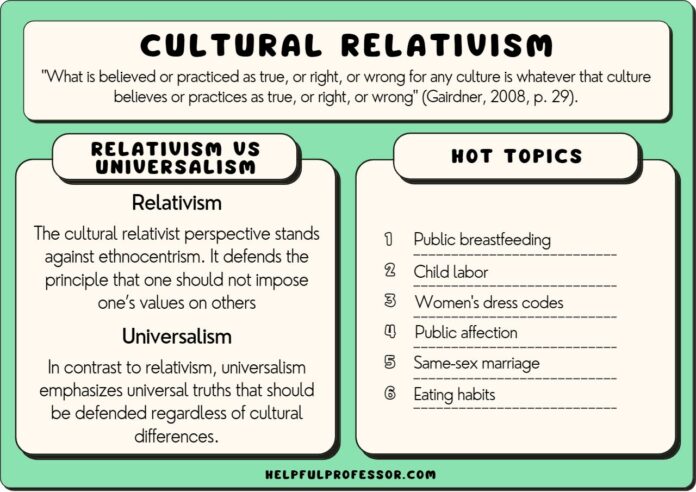Cultural relativism invites individuals to reevaluate the entrenched norms that govern diverse societies. The intricate web of cultural practices, beliefs, and values may appear daunting. Yet, a diagrammatic representation can elucidate this multifaceted concept. By visually navigating through cultural relativism, we unveil insights that promise a transformative shift in perspective.
The Paradigm of Cultural Relativism
Cultural relativism posits that a person’s beliefs and activities should be understood based on that individual’s own culture, rather than be judged against the criteria of another culture. This fundamental principle resonates in anthropological discourse and social science.
Diagrammatically, this paradigm can be represented through a series of concentric circles, each symbolizing varying cultural dimensions. For instance, the innermost circle might denote personal beliefs and immediate social circles, whereas subsequent layers may encompass broader societal norms, regional practices, and national ideologies.
Examining this model encourages critical reflection: How do our personal experiences shape our understanding of societal practices? Are we, as observers from a particular cultural standpoint, imposing our values upon others? Through dialogic engagement with such visuals, individuals not only pique their curiosity but also embark on a journey of greater empathy and understanding.
Bridging Different Cultural Landscapes
To comprehend cultural relativism effectively, one must also explore the frameworks through which differing cultures interact. A diagram that represents the clash and conflation of various cultural realms can enhance this understanding.
Imagining a Venn diagram with overlapping circles representing distinct cultural groups exemplifies the convergence and divergence of cultural practices. The intersections may reveal shared values, while the non-overlapping segments serve to highlight uniqueness and difference. This visualization encourages contemplation about inclusivity: how can we celebrate cultural individuality while fostering communal harmony?
Understanding cultural relativism through this lens also emphasizes the interplay of power dynamics. Often, dominant cultures, through globalization and colonial legacies, impose their values upon marginalized communities. By visually representing these interactions, it becomes easier to pinpoint cultural appropriation and advocating for genuine cultural exchange rather than mere exploitation.
Empathy and Perspective Shift: A Visual Journey
Cultural relativism is not solely an intellectual exercise; it is an emotional and ethical journey that advocates empathy. A diagram that illustrates the spectrum of empathy, ranging from ignorance to understanding, can serve as an invaluable tool.
On one end, we encounter cultural ignorance, where misconceptions proliferate and entrenched biases prevail. Conversely, the opposing end embodies cultural competence, marked by profound understanding and respect for cultural diversity. A vertical scale demonstrating this continuum can visually encapsulate where individuals position themselves amid these contrasting viewpoints.
Plotting oneself on this continuum invites introspection and growth. Would there be a willingness to engage with differing cultural narratives? To foster mutual respect? By acknowledging our biases and striving towards understanding, individuals can cultivate a more nuanced worldview.
Cultural Illustrations: The Power of Representation
Diagrammatic representation can also extend to the artistic portrayal of cultural elements. Images and symbols serve as potent vehicles for communication. When incorporating visual representations of various cultural artifacts and practices into diagrams, we broaden the dialogue surrounding cultural relativism.
Consider an infographic depicting an array of cultural symbols—traditional clothing, festivals, culinary practices, and more. Each symbol is accompanied by a succinct explanation, illuminating its importance within its respective culture. This approach instills curiosity, inviting viewers to explore beyond mere appearances and engage with deeper meanings.
Using such diagrams can stimulate conversations about cultural appreciation versus appropriation. In an age where global interconnectivity often blurs cultural boundaries, the distinction becomes vital. As individuals scrutinize the meanings attached to cultural symbols, they foster an environment of awareness and respect.
The Role of Education in Cultural Relativism
Education plays a pivotal role in the dissemination of cultural relativism. An educational model that incorporates diagrammatic representations can enhance comprehension and retention.
Imagine a classroom setting where students engage with a series of diagrams representing distinct societal structures and cultural practices. By synthesizing these visuals with interactive discussions, learners can actively participate in knowledge construction.
Moreover, utilizing digital platforms to present these diagrams fosters enhanced engagement among diverse audiences. Such accessibility can bridge generational and geographical gaps, further amplifying the narratives of underrepresented cultures.
Critical Reflections and Challenges in Diagrammatic Representation
While diagrammatic representation serves as an effective tool in elucidating cultural relativism, it is imperative to acknowledge inherent challenges. Visual simplification, for instance, may inadvertently erase the nuances of complex cultural narratives. Each diagram is a representation, not a complete depiction.
Therefore, engaging with multiple perspectives is crucial. When utilizing diagrams, creators should strive for inclusivity, ensuring that varied voices are represented accurately and respectfully. Engaging cultural representatives in the diagrammatic creation process fosters authenticity and enriches the conversation surrounding cultural relativism.
Moving Forward: Embracing Cultural Dynamics with Curiosity
Through diagrammatic representation, the multifaceted nature of cultural relativism becomes more accessible. This method not only enhances understanding but also prompts individuals to cultivate a sense of curiosity about the diverse cultural landscapes that exist within society.
In conclusion, the significance of cultural relativism flows beyond academic debate; it beckons individuals to engage with the human experience in its myriad forms. By employing diagrams, we maintain an openness to learning, challenging preconceived notions, and embracing the richness of diversity. Through such engagement, a more compassionate society can emerge—one that honors differences while nurturing a profound collective humanity.





























